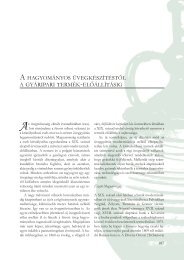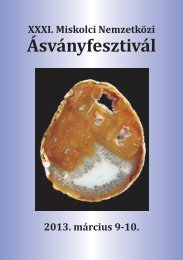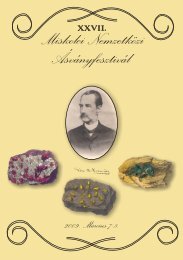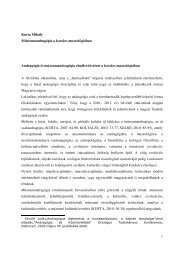Acta Mineralogica-Petrographica, Abstract Series 5, Szeged, 2006<strong>THE</strong> PROTON: A CATION LIKE <strong>THE</strong> O<strong>THE</strong>RS <strong>IN</strong> ROCK-FORM<strong>IN</strong>G <strong>M<strong>IN</strong>ERAL</strong>SROBERT, J.-L.ISTO, UMR 6113, CNRS-Université d’Orléans, 45071 Orléans Cedex 2, France and IMPMC, UMR 7590, CNRS-UniversitésParis VI, Paris VII, IPG, 140 rue de Lourmel, 75015 Paris, FranceE-mail: jlrobert@cnrs-orleans.frIn hydrous rock-forming minerals, the hydroxyl hydrogenand the hydroxyl oxygen are usually considered as a wholeand permanent entity, i.e. the hydroxyl group, which acts as amonovalent anion within the structure. The reality is morecomplicated and more interesting, since the hydroxyl protonleads its life independently. Depending on the local chargebalances, the hydroxyl group can be considered as a pointcharge or as dipole in which oxygen and hydrogen play adifferent role, since hydrogen is able to share a part of itscharge with surrounding oxygens, usually the underbondedoxygens of adjacent tetrahedra.The properties of the OH group (O–H distance and resultingO–H stretching and bending wavenumbers) closely reflectthe local variations of crystal-chemical properties in themineral structure: charge distributions, and distances. Anexamination of these properties allow a careful description ofthe crystal-chemical landscape around the proton, up to thefifth cationic neighbour in favourable cases, and a predictionof many geochemical properties of H-bearing rock-formingphases.The main factor controlling these properties is the nature(bulk charge, electronegativity) of the first cationicneighbours. The higher the bulk charge carried by the immediatelyadjacent cations, the weaker the O–H bond within thehydroxyl group. Contrary to a commonly accepted idea, theorientation of the OH dipole is not the main factor controllingthese properties. An example is given by the comparisonbetween talc Mg 3 Si 4 O 10 (OH) 2 , a trioctahedral 2:1 layer silicate,with the OH dipole bonded to Mg 3 and perpendicular to(001), and pyrophyllite, (Al 2 )Si 4 O 10 (OH) 2 ( stands for anoctahedral vacancy), with the OH group adjacent to Al 2 and strongly tilted towards (001). The resulting OH bondstrength is the same in talc and pyrophyllite, as shown by thesimilarity between their OH-stretching wavenumbers (3676 ±1 cm –1 ). As long as the local charge balance around the OHgroup remains constant, the bond strength within the OHgroup and the resulting OH-stretching wavenumber remainconstant, whatever the mineral family. It is interesting to notethat the trioctahedral OH group in the tetrasilicic magnesiummica K(Mg 2.5 0.5 )Si 4 O 10 (OH) 2 , in richterite, a clinoamphibole,(K,Na)(NaCa)Mg 5 Si 8 O 22 (OH) 2 , and the inner OH-groupin dravite, a tourmaline, NaMg 3 Al 6 (BO 3 ) 3 (Si 6 O 18 )(OH)(OH) 3 ,have the same OH-stretching wavenumber, 3735 cm –1 , withinexperimental uncertainties. In these there major silicate families,the OH group is bonded to Mg 3 and point towards analkaline cation, in the middle of a ring of six SiO 4 tetrahedra,which can be summarised as follows: Mg 3 -OH → (6SiO 4 )-A +(with A + = Na + or K + ).A decrease of the local charge carried by the first adjacentcations raises the O–H bond strength and consequently theOH-stretching wavenumber, up to 3755 cm –1 , the highestvalue known in any compound under room conditions, observedin tainiolite K(Mg 2 Li)Si 4 O 10 (OH) 2 . By contrast, as thebulk charge carried by the first cationic neighbours increases,for example Mg 2 Al or Al 2 Li, the OH-stretching wavenumberdrops to values around or below 3650 cm –1 , indicating that apart of the proton charge is shared with surrounding oxygens.This is observed in all mineral families.Heterovalent cationic substitutions in octahedral sites adjacentto the OH-group are generally coupled with replacementsin other polyhedra, e.g. the tetrahedral sites, the interlayerspace in layer silicates, the pseudo-cubic antiprism M4site in amphiboles, the second, third, …, neighbours, must beconsidered.Using selected synthetic minerals allows to determine therespective influence of all substitutions, up to the fifth cationicneighbouring sites in favourable cases, through a carefulanalysis of the perturbations induced on the OH group. In thisway, it is possible to assign all observed OH vibrations to apeculiar environment, and then to deduce local order-disorderrelations around the hydroxyl proton.The influence of the A + cation can be analysed using A + -bearing and A + -free minerals. For example, the influence ofK + on hydroxyl properties can be deduced from the comparisonbetween talc [Mg 3 –OH → (6SiO 4 )] and the trioctahedralOH of the tetrasilicic Mg mica [Mg 3 –OH → (6SiO 4 )–K]. Theshift induced by K + facing the OH group is +59 cm –1 . A similarvalue is observed in amphiboles, for example betweentremolite Ca 2 Mg 5 Si 8 O 22 (OH) 2 and richteriteA + (NaCa)Mg 5 Si 8 O 22 (OH) 2 , and in tourmalines, Mg-foitite(Mg 2 Al) Al 6 (BO 3 ) 3 (Si 6 O 18 )(OH)(OH) 3 , compared to draviteNaMg 3 Al 6 (BO 3 ) 3 (Si 6 O 18 )(OH)(OH) 3 . Increasing the charge ofthe cation facing the hydroxyl group raises the OH-stretchingwavenumber, as observed along the phlogopiteKMg 3 (Si 3 Al)O 10 (OH) 2 –kinoshitalite BaMg 3 (Si 2 Al 2 )O 10 (OH) 2join, where the K + /Ba 2+ substitution provokes a shift of +20cm –1 in the OH-stretching wavenumber. The tilting of the OHgroup towards (001) in dioctahedral phases withdraws thisinteraction, as shown by the comparison between muscoviteor paragonite A + (Al 2 )(Si 3 Al)O 10 (OH) 2 , with A + = K + andNa + , respectively, and phlogopite KMg 3 (Si 3 Al)O 10 (OH) 2 .Contrary to a commonly accepted belief, the effect of theorientation of the OH group on the exchange properties ofclay minerals is practically negligible, since the interlayerwater molecules act as a screen between the hydroxyl protonand the compensating cation, and there is almost no interactionbetween them even in the case of trioctahedral smectites,like saponites. As a matter of fact, in one-layer high-chargesaponites, the OH-stretching wavenumber is only 3682 cm –1 ,e.g. very close to that of talc, a 2:1 layer silicate withoutinterlayer compensating cation. Therefore, in smectites, onlythe charge location and the charge value have an influence onexchange properties, and the behaviours of the dioctahedralbeidellites and trioctahedral saponites, both with tetrahedralcharge, on one side, and of the dioctahedral montmorillonitesand the trioctahedral hectorites, both with octahedral charge,102www.sci.u-szeged.hu/asvanytan/acta.htm
Acta Mineralogica-Petrographica, Abstract Series 5, Szeged, 2006on the other side, are similar provided that the layer charge isthe same.The properties of the OH-group also allow to investigatethe tetrahedral cationic distributions (mainly Si, Al), since theOH … O interactions depend on the charge balance on surroundingoxygens, i.e. the oxygens of tetrahedra. A carefulquantitative investigation of OH-stretching band intensitiesfor different first neighbours (octahedral), and secondneighbours (tetrahedral) shows that the Si, Al distributionsare generally not ordered, but follow a homogeneous chargedistribution pattern, in agreement with high-resolution NMRdata. Considering the influence of second cationic neighbourseffects (i.e. tetrahedrally coordinated cations), on band positionsand band intensities, leads to conclude that in manycases the extinction coefficients are constant, which allowquantitative determinations of cationic distributions aroundthe hydroxyl proton.The method is sensitive enough to enlight long distanceeffects, even for subtle substitutions like Ca 2+ /Mg 2+ at M4sites in clinoamphiboles along the tremoliteCa 2 Mg 5 Si 8 O 22 (OH) 2 –cummingtonite Mg 7 Si 8 O 22 (OH) 2join, or Na + /Li + along the ferri-clinoferroholmquistiteLi 2 Fe 2+ 3Fe 3+ 2Si 8 O 22 (OH) 2 –riebeckiteNa 2 Fe 2+ 3Fe 3+ 2Si 8 O 22 (OH) 2 series. Owing to the distances,these long-range effects are not direct. They are inducedthrough the structure by the propagation of tiny distortionsrequired by local charge balance requirements.In addition to this role of privileged observer, the protonH + frequently plays a key role in many situations. Deprotonationin the case of in situ oxidation of a variable chargecation, i.e. Fe 2+ → Fe 3+ , in biotites, hornblendes, and so, noprotonation when high cation (Mn 3+ , Ti 4+ ) are incorporated tocrystal structures, in micas like norrishiteK(Mn 3+ 2Li)Si 4 O 10 O 2 and many high-Ti phlogopites, or amphiboleslike ungarettiite NaNa 2 (Mn 2+ 2Mn 3+ 3)Si 8 O 22 O 2 , obertiiteNaNa 2 (Mg 3 Fe 3+ Ti)Si 8 O 22 O 2 and dellaventuraiteNaNa 2 (MgMn 3+ 2LiTi) Si 8 O 22 O 2 . Additional protonations arealso known in hydrous minerals, for example in partiallydioctahedral micas with a tetrahedrally coordinated cation,Be 2+ , Mg 2+ , Ni 2+ or Co 2+ , or in clinoamphiboles (richterites),with Li + replacing Ca 2+ at the M4 site.The approach is also very useful for identifying unusualcoordinations for cations, for example [4] M 2+ in micas and inamphiboles like joesmithite, PbCa 2 Mg 5 (Si 6 Be 2 )O 22 (OH) 2 , or[4] B 3+ in high pressure olenite (a tourmaline)NaAl 3 Al 6 (BO 3 ) 3 (Si 3 B 3 O 18 )(OH)(OH) 3 .The interactions of the hydroxyl proton with theneighbouring oxygens, influenced by the charge distributionsand the distances, also control the possible OH – /F – exchangeproperties, whatever the fluorine activity in the environment.When the hydroxyl proton has no or little interactions with itsneighbours, it acts as a point charge in the structure and theOH – /F – is easy. It is the case in most trioctahedral layer silicates,in all amphiboles and at the inner OH – site of tourmalines.By contrast, if the hydroxyl proton is involved in H-bonds with surrounding oxygens, its replacement by fluorineis more energetically difficult, and becomes impossible ifOH … O bonds are strong. It is why dioctahedral layer silicatesdo not trap much fluorine, and why outer hydroxyl groupscannot be replaced by fluorine in tourmalines.www.sci.u-szeged.hu/asvanytan/acta.htm 103
- Page 1:
MSCC33 rd MINERAL SCIENCES IN THE C
- Page 5 and 6:
Acta Mineralogica-Petrographica, Ab
- Page 7 and 8:
Acta Mineralogica-Petrographica, Ab
- Page 9 and 10:
Acta Mineralogica-Petrographica, Ab
- Page 11 and 12:
Acta Mineralogica-Petrographica, Ab
- Page 13 and 14:
Acta Mineralogica-Petrographica, Ab
- Page 15 and 16:
Acta Mineralogica-Petrographica, Ab
- Page 17 and 18:
Acta Mineralogica-Petrographica, Ab
- Page 19 and 20:
Acta Mineralogica-Petrographica, Ab
- Page 21 and 22:
Acta Mineralogica-Petrographica, Ab
- Page 23 and 24:
Acta Mineralogica-Petrographica, Ab
- Page 25 and 26:
Acta Mineralogica-Petrographica, Ab
- Page 27 and 28:
Acta Mineralogica-Petrographica, Ab
- Page 29 and 30:
Acta Mineralogica-Petrographica, Ab
- Page 31 and 32:
Acta Mineralogica-Petrographica, Ab
- Page 33 and 34:
Acta Mineralogica-Petrographica, Ab
- Page 35 and 36:
Acta Mineralogica-Petrographica, Ab
- Page 37 and 38:
Acta Mineralogica-Petrographica, Ab
- Page 39 and 40:
Acta Mineralogica-Petrographica, Ab
- Page 41 and 42:
Acta Mineralogica-Petrographica, Ab
- Page 43 and 44:
Acta Mineralogica-Petrographica, Ab
- Page 45 and 46:
Acta Mineralogica-Petrographica, Ab
- Page 47 and 48:
Acta Mineralogica-Petrographica, Ab
- Page 49 and 50:
Acta Mineralogica-Petrographica, Ab
- Page 51 and 52: Acta Mineralogica-Petrographica, Ab
- Page 53 and 54: Acta Mineralogica-Petrographica, Ab
- Page 55 and 56: Acta Mineralogica-Petrographica, Ab
- Page 57 and 58: Acta Mineralogica-Petrographica, Ab
- Page 59 and 60: Acta Mineralogica-Petrographica, Ab
- Page 61 and 62: Acta Mineralogica-Petrographica, Ab
- Page 63 and 64: Acta Mineralogica-Petrographica, Ab
- Page 65 and 66: Acta Mineralogica-Petrographica, Ab
- Page 67 and 68: Acta Mineralogica-Petrographica, Ab
- Page 69 and 70: Acta Mineralogica-Petrographica, Ab
- Page 71 and 72: Acta Mineralogica-Petrographica, Ab
- Page 73 and 74: Acta Mineralogica-Petrographica, Ab
- Page 75 and 76: Acta Mineralogica-Petrographica, Ab
- Page 77 and 78: Acta Mineralogica-Petrographica, Ab
- Page 79 and 80: Acta Mineralogica-Petrographica, Ab
- Page 81 and 82: Acta Mineralogica-Petrographica, Ab
- Page 83 and 84: Acta Mineralogica-Petrographica, Ab
- Page 85 and 86: Acta Mineralogica-Petrographica, Ab
- Page 87 and 88: Acta Mineralogica-Petrographica, Ab
- Page 89 and 90: Acta Mineralogica-Petrographica, Ab
- Page 91 and 92: Acta Mineralogica-Petrographica, Ab
- Page 93 and 94: Acta Mineralogica-Petrographica, Ab
- Page 95 and 96: Acta Mineralogica-Petrographica, Ab
- Page 97 and 98: Acta Mineralogica-Petrographica, Ab
- Page 99 and 100: Acta Mineralogica-Petrographica, Ab
- Page 101: Acta Mineralogica-Petrographica, Ab
- Page 105 and 106: Acta Mineralogica-Petrographica, Ab
- Page 107 and 108: Acta Mineralogica-Petrographica, Ab
- Page 109 and 110: Acta Mineralogica-Petrographica, Ab
- Page 111 and 112: Acta Mineralogica-Petrographica, Ab
- Page 113 and 114: Acta Mineralogica-Petrographica, Ab
- Page 115 and 116: Acta Mineralogica-Petrographica, Ab
- Page 117 and 118: Acta Mineralogica-Petrographica, Ab
- Page 119 and 120: Acta Mineralogica-Petrographica, Ab
- Page 121 and 122: Acta Mineralogica-Petrographica, Ab
- Page 123 and 124: Acta Mineralogica-Petrographica, Ab
- Page 125 and 126: Acta Mineralogica-Petrographica, Ab
- Page 127 and 128: Acta Mineralogica-Petrographica, Ab
- Page 129 and 130: Acta Mineralogica-Petrographica, Ab
- Page 131 and 132: Acta Mineralogica-Petrographica, Ab
- Page 133 and 134: Acta Mineralogica-Petrographica, Ab












